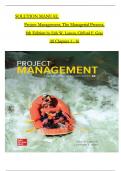SOLUTION MANUAL
Project Management, The Managerial Process,
8th Edition
by Erik W. Larson, Clifford F. Gray
All Chapters 1 - 16
1 / 4
TABLE OF CONTENTS
Ch. 1 Modern Project Management
Ch. 2 Organization Strategy and Project Selection
Ch. 3 Organization: Structure and Culture
Ch. 4 Defining the Project
Ch. 5 Estimating Project Times and Costs
Ch. 6 Developing a Project Schedule
Ch. 7 Managing Risk
Ch. 8 Scheduling Resources and Costs
Ch. 9 Reducing Project Duration
Ch. 10 Being an Effective Project Manager
Ch. 11 Managing Project Teams
Ch. 12 Outsourcing: Managing Interorganizational Relations
Ch. 13 Progress and Performance Measurement and Evaluation
Ch. 14 Project Closure
Ch. 15 Agile Project Management
Ch. 16 International Projects
2 / 4
Chapter 1
Modern Project Management
Chapter Outline
1. What Is a Project?
A. What a Project Is Not
B. Program versus Project
C. The Project Life Cycle
D. The Project Manager
E. Being Part of a Project Team
2. Agile Project Management
3. Current Drivers of Project Management
A. Compression of the Product Life Cycle
B. Knowledge Explosion
C. Triple Bottom Line (Planet, People, Profit)
D. Increased Customer Focus
E. Small Projects Represent Big Problems
4. Project Management Today: A Socio-Technical Approach
5. Summary
6. Text Overview
7. Key Terms
8. Review Questions
9. Snapshot from Practice: Discussion Questions
10. Exercises
11. Case 1.1: A Day in the Life —2019
12. Case 1.2: The Hokies Lunch Group
3 / 4
Chapter Learning Objectives
After reading this chapter you should be able to:
LO 1-1 Understand why project management is crucial in today ’s world.
LO 1-2 Distinguish a project from routine operations.
LO 1-3 Identify the different stages of a project life cycle.
LO 1-4 Describe how Agile PM is different from traditional PM.
LO 1-5 Understand that managing projects involves balancing the technical and
sociocultural dimensions of the project.
Review Questions
1. Define a project. What are five characteristics which help differentiate projects
from other functions carried out in the daily operations of the organization?
A project is a complex, non-routine, one-time effort limited by time, budget, resource,
and specifications. Differentiating characteristics of projects from routine, repetitive daily
work are below:
a. A defined lifespan
b. A well-defined objective
c. Typically involves people from several disciplines
d. A project life cycle
e. Specific time, cost, and performance requirements.
2. What are some of the key environmental forces that have changed the way
projects are managed? What has been the effect of these forces on the
management of projects?
Some environmental forces that have changed the way we manage projects are the
product life cycle, knowledge growth, global competition, organization downsizing,
technology changes, time- to-market. The impact of these forces is more projects per
organization, project teams responsible for implementing projects, accountability,
changing organization structures, need for rapid completion of projects, linking
projects to organization strategy and customers, prioritizing projects to conserve
organization resources, alliances with external organizations, and so on.
3. Describe the four phases of the traditional project life cycle. Which phase do you
think would be most the difficult one to complete? Powered by TCPDF (www.tcpdf.org)
4 / 4




